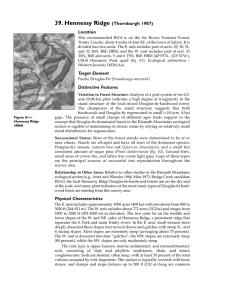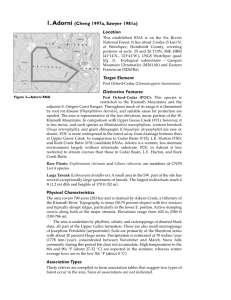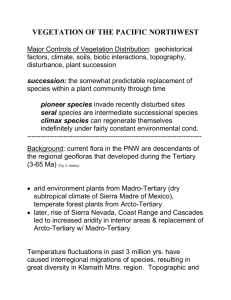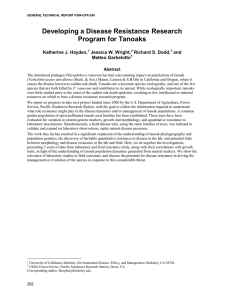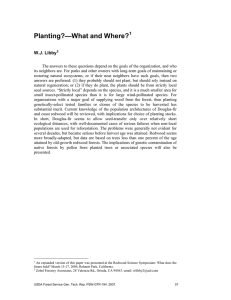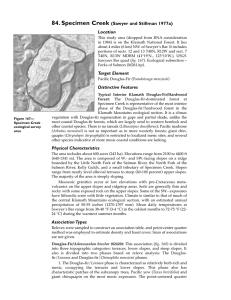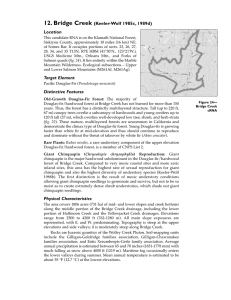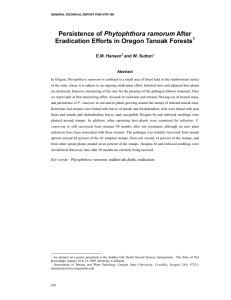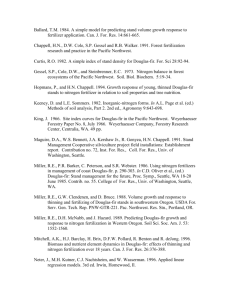Orleans Complex Fire Behavior, Fuels, and Effects Jo Ann Fites, Team Leader
advertisement
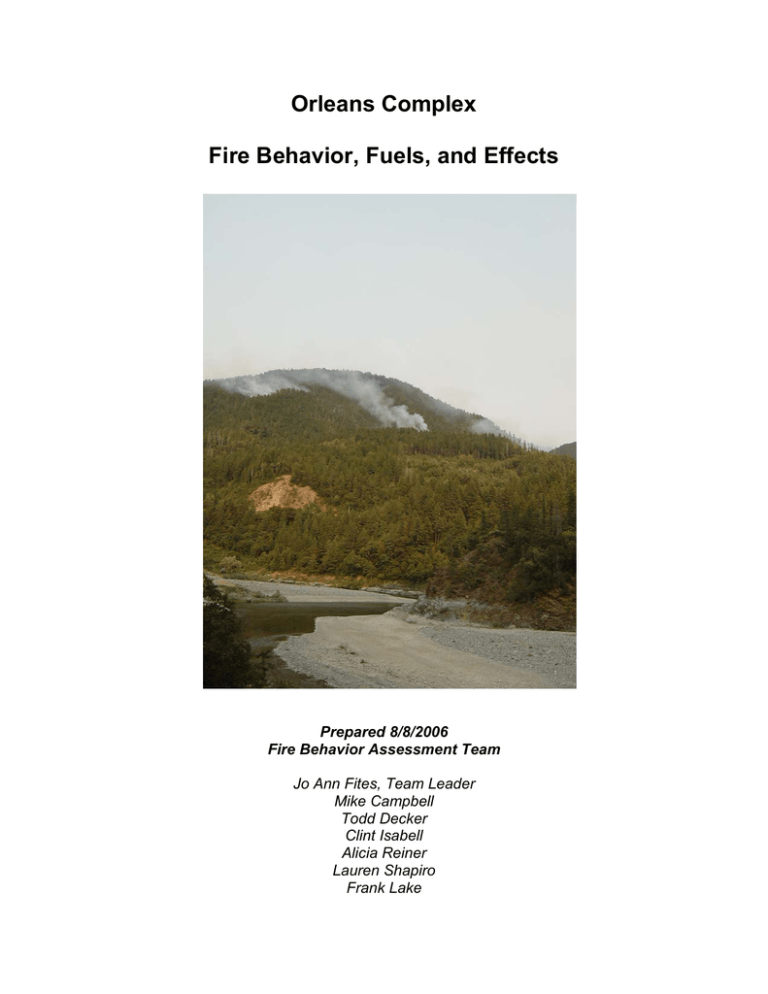
Orleans Complex Fire Behavior, Fuels, and Effects Prepared 8/8/2006 Fire Behavior Assessment Team Jo Ann Fites, Team Leader Mike Campbell Todd Decker Clint Isabell Alicia Reiner Lauren Shapiro Frank Lake 9/5/2006 draft 2:32 PM Contents Executive Summary 3 Introduction Background Objectives Applications 4 4 4 4 Approach Fire Behavior Measurements and Observations Vegetation and Fuels Measurements Additional Measurements in Culturally Important Plant Communities Findings Overall Pre-fire Fuels Fire Behavior Post-fire Fuels, Consumption & Overall Effects Vegetation Composition and Fire Effects 4 5 5 6 8 8 10 13 17 Appendix A: About the FBAT team 37 Appendix B: Fire Temperature Data (Sites 1 and 2 only) 39 2 9/5/2006 draft 2:32 PM Executive Summary Wildland fire management, prescribed fire planning and implementation, and wildfire suppression is dependent upon good fire behavior and resource effects predictions. Existing fire behavior and resource effects prediction models are based upon limited data from fire in the field, especially quantitative data. The Fire Behavior Assessment Team (FBAT) collects data to improve our ability to predict fire behavior and resource effects in the long-term and provides shortterm intelligence to communities, tribes, managers and wildfire incident management teams on fire behavior-fuel and effects relationships. The team also collects information on community and fire fighter safety, such as convective heat in safety zones as opportunities arise. This report contains the results of the assessment of fire behavior in relation to fuels, weather and topography, and fire effects to resources in relation to fire behavior for the Somes fire, part of the Orleans Complex. Objectives The team met with the Forest, District and Karuk Tribe to prioritize vegetation and fuel types and resources to focus on. The priorities were: 1. fire behavior and effects in plant communities culturally important to the Karuk Tribe 2. fire effects and behavior in relation to fuels, topography and weather within the Orleans Fire Safe Council Orleans Community Project Area to provide information for future management plans. Accomplishments • fire behavior and effects in culturally important plant communities - 4 sites completed (video, rate of spread, fuels and vegetation pre and post) • fire behavior and effects in representative fuel types within the Orleans Fire Safe Council Community Protection Planning Area - 5 sites completed (video, rate of spread, fuels and vegetation pre and post) • foliar moisture samples were collected and processed along several divisions and submitted to FBAN. 3 9/5/2006 draft 2:32 PM INTRODUCTION Background Wildland fire management, prescribed fire planning and implementation, and wildfire suppression is dependent upon good fire behavior and resource effects predictions. Existing fire behavior and resource effects prediction models are based upon limited data from fire in the field, especially quantitative data. The Fire Behavior Assessment Team (FBAT) collects data to improve our ability to predict fire behavior and resource effects in the long-term and provides shortterm intelligence to communities, tribes, managers and wildfire incident management teams on fire behavior-fuel and effects relationships. The team also collects information on community and fire fighter safety, such as convective heat in safety zones as opportunities arise. This report contains the results of the assessment of fire behavior in relation to fuels, weather and topography, and fire effects to resources in relation to fire behavior for the Orleans Complex. Objectives The team met with the Forest, District and Karuk Tribe to prioritize vegetation and fuel types and resources to focus monitoring on. The objectives were based on providing information useful for planning future cultural burning projects and community protection fuel hazard reduction projects. The priorities were: fire behavior and effects in plant communities culturally important to the Karuk Tribe 2. fire effects and behavior in relation to fuels, topography and weather within the Orleans Fire Safe Council Orleans Community Project Area. 1. Potential Application of Information The monitoring data and assessment will be useful for characterizing fuels and fire effects, and prescription development for prescribed burn planning and fuel hazard project planning. If the sites are revisited at a later date to gather longerterm fire effects information, then the data will be useful for predicting longer-term post-fire effects, such as the effect of summer burning on culturally important plants. APPROACH Pre- and post-fire fuels and fire behavior measurements were made at sites throughout the fire. Sites were selected based on the presence of culturally important plants and plant community types and to represent a variety of fire behavior and vegetation or fuel conditions. Priority was on sites that would most 4 9/5/2006 draft 2:32 PM likely receive fire. Because of the additional objective of monitoring in culturally important plant communities, more detail on plant species composition was gathered than typical. Fire Behavior Measurements and Observations At each site, sensors were set up to gather information on fire behavior including: rate of spread, fire type, flamelength, and flaming duration. In addition, at some sites, temperature was also measured, particularly where culturally important trees or plants occurred. Flamelength and Flaming Duration Flamelength was determined from video and sometimes supplemented by tree height or char. If crowning occurred above the view of the camera, then tree height was used to estimate the minimum flamelength. If the video camera failed (due to extreme temperatures or trigger malfunction), then char height on tree boles or direct observation were used to estimate flamelength. Flaming duration was based on direct video observation and when temperature was measured, from those sensors as well. Fire Type Fire type was determined from video as well as post-fire effects at each site. Observations from the video were recorded on transitions to crown fire, including the type of fuel that carried the fire from the surface to crown. Rate of Spread and Temperature Rate of spread was determined by rate of spread sensors (RASPS) which have a piece of solder attached to a computer chip (buried in the ground) that records the date and time when the solder melts or from thermocouples that measure temperature. The distance and angle between RASPS or thermocouples were measured. In some cases where the RASPS failed, rate of spread was estimated from the video. Thermocouples were placed at two sites were cultural resources were present or placed. Vegetation and Fuel Measurements Vegetation and fuels were inventoried before the fire reached each site and then after. Consumption and fire effects (i.e. scorch) were inventoried after burning. Mortality was not determined for trees, since mortality can be delayed for some time after the fire. Vegetation Composition, Structure and Fuels Tree density, basal area, tree diameters, tree heights and canopy base heights were measured by species for each site. A relaskop was used for overstory and pole plots. Heights were measured with an impulse laser. Diameters were measured with a biltmore stick or in some cases a diameter tape. On some very 5 9/5/2006 draft 2:32 PM steep sites, diameters were measured for some trees for calibration and then the remaining trees estimated. The GAMMA program was used to calculate canopy bulk density, canopy base height, tree density and basal area. Surface fuels were inventoried with a Brown’s planar intercept. Understory vegetation and live fuels were estimated occularly in a 1 meter wide belt plot along the Brown’s transect. The Burgan and Rothermel fuels photo series was used in order to estimate tons per acre of live fuels. Duff pins were placed along the fuels transect line to measure litter and duff consumption. Understory composition including herbs, grasses, shrubs and tree seedlings was measured by ocular estimation of canopy cover within a 3.28 by 50 foot belt transect along the Brown’s planar intercept line. The proportion of dead vegetation and average height by species was recorded. Additional Measurements in Culturally Important Plant Communities Greater detail on plant species composition was recorded at sample sites in culturally important plant communities. In addition, stem density was recorded for clumps of culturally important shrubs that were within the belt transect or sometimes adjacent to them (e.g., Figure 1). Condition of the stems relative to cultural uses was also noted, such as presence of defects in the stems (i.e. evidence of insects) and form. Duff pins were placed at the base of some culturally important trees (i.e. gathering trees) to measure consumption where deeper litter and duff had accumulated compared to adjacent areas. Figure 1. Transect next to hazel shrub, where additional data on stem density and form (related to Karuk cultural uses) was gathered. 6 9/5/2006 draft 2:32 PM Foliar Moisture and Weather Live foliage was collected on each plot and oven dried to determine foliar moisture. Weather data was downloaded from the Orleans lookout remote automated weather station (RAWS). 7 9/5/2006 draft 2:32 PM Findings OVERALL A total of 9 sites were grouped into vegetation types based on dominant overstory trees and presence of understory plants important to the Karuk tribe (Figure 2, Table 1). Seven different vegetation types were sampled, most with only one plot per type, except for the Douglas-fir – tanoak plant community, represented by three plots. The first four plant communities contain one or several plants or gathering trees important to the Karuk tribe. These sites included large tanoaks, prince’s pine (Chimaphylla umbellate), hazel, ironwood (Holodiscus discolor), oregon grape, or gooseberry. Table 1. Vegetation types assigned to each site and used to group data. Vegetation Type Description Number of Sites Sampled Douglas-fir /Arnica Higher elevation, open old-growth Douglas1 fir. Some white fir regeneration. Arnica and prince’s pine in understory. On slopes (site 4). 2 Douglas-fir - tanoak Dense Douglas-fir and tanoak, with medium to large trees of tanoak and Douglas-fir on benches. Dense understory of young to midsized tanoak. Sparse shrubs and herbs. (sites 2,3,8) Douglas-fir/hazel – Moderately dense to open Douglas-fir with 1 ironwood well developed shrub layer of hazel and ironwood. Heavy cover of feathered moss on rocky surface. (site 1) 1 DouglasOpen, old growth and mature Douglas-fir with fir/gooseberry – scattered mature live oak and big leaf maple. ironwood Large, well developed patch of gooseberry and ocean spray on bench at headwater of south fork Perch Creek. (site 5) 1 Douglas-fir – live oak Moderately dense canyon live oak and some madrone, with scattered stumps and some live trees of Douglas-fir. Sparse understory. (site 9) Douglas-fir Very dense, young Douglas-fir with little 1 plantation understory. Some patches of Oregon grape and scattered poison oak. (site 7) Live oak – rock Dense patches of small canyon live oak 1 outcrop clumps, some smaller Douglas-fir interspersed with moss covered rock outcrops. Sedum and alum root on rock outcrops. (site 6) 8 9/5/2006 draft 2:32 PM 9 9/5/2006 draft 2:32 PM Forest structure and plant community composition varied by vegetation type and site (table 2, tables 10a-10i). Basal areas were lowest in the open Douglasfir/Arnica and Douglas-fir/gooseberry-ironwood plant communities, the Douglasfir plantation and one of the Douglas-fir tanoak sites. The Douglas-fir – canyon live oak and one of the Douglas-fir tanoak sites had the greatest stem densities, comprised mostly of medium to small sized hardwoods. Mean tree diameters were low but large (>40” dbh) Douglas-fir and tanoak (>24” dbh) were recorded on all sites but the plantation, harvested Douglas-fir – canyon live oak and the canyon live oak- rock outcrop sites. Table 2. Pre-fire forest structure calculated using GAMMA (Wilson 2006), based on Forest Vegetation Simulator equations with additions to include California hardwood crown fuels. Site Basal Area Trees per Quadratic Trees per Trees per (ft2/acre) Acre Mean acre >24” acre >30” diameter dbh dbh (inches) Douglas-fir /Arnica 4 150 22 36.4 22 12 Douglas-fir - tanoak 2 360 1416 6.8 39 18 3 165 143 14.5 4 4 8 380 362 13.9 16 6 Douglas-fir / hazel-ironwood 1 4501 324 16.0 48 17 Douglas-fir /gooseberry-ironwood 5 180 87 19.5 18 11 Douglas-fir – canyon live oak 9 210 2149 4.2 0 0 Canyon live oak/rock outcrop 7 * * 1.2 42 * Douglas-fir plantation 6 150 370 8.6 0 0 * Site 7 is more aptly defined as a shrub type, so trees per acre and canopy bulk density are not appropriate. 1 – basal area may be lower, plot installed rapidly and borderline trees not checked precisely. 2-one medium Douglas-fir in plot, but when expanded to per acre value, comes out as 4/acre. 10 9/5/2006 draft 2:32 PM PRE-FIRE FUELS Pre-fire Dead Surface Fuels Surface fuels were greatest in the Douglas-fir –tanoak, Douglas fir/hazelironwood sites. (Table 3). Overall, surface fuels generally exceeded 8 to 10 tons/acre, excluding litter and duff. Litter and duff layers were well developed on all sites except the steep Douglas-fir/Arnica, the Douglas-fir plantation, and the live oak-rock outcrop site. On sites with well developed litter and duff layers, surface fuel loadings will be greater than that estimated based on the stick counts alone but coefficients were not available to translate the depths into tons/acre. Table 3. Surface, dead woody fuels by site. Small surface fuels (tons/acre) Site 1 hour1 10 hour 4 .1 .9 2 3 8 .3 .7 .5 2.1 1.5 2.2 1 .6 1.5 5 .4 2.1 9 .4 .9 7 .2 .3 6 .2 0 100 hour Total 1000 hour fuels (tons/acre) Rotten Sound Douglas fir – Arnica 1 7.9 0 Douglas fir – tanoak 2.4 4.9 9.7 0 6.1 8.3 .7 2.1 .6 3.2 3.4 5.7 Douglas fir – hazel-ironwood 1.2 3.4 3.8 5.6 Douglas fir – gooseberry-ironwood 8.5 11 .7 0 Douglas fir – live oak 6.1 7.3 0 .6 Live oak – rock outcrop 0 .5 .2 0 Douglas fir – plantation 0 0 .2 0 0 Forest floor depths (inches) Litter Duff Fuel bed (ft) .4 1.4 .48 1.2 1.2 1.6 1.8 2.2 1 .36 .39 1 .8 .62 2.0 1.6 .37 1.4 .4 .33 .2 0 .35 .4 .4 .17 1- does not include litter, although litter contributes significantly to 1-hour fuels. Litter was not included because there are not coefficients specific to these vegetation types. Pre-fire Live Fuels Canopy bulk densities were highest on the sites dominated by smaller younger trees, the plantation and the Douglas-fir – canyon live oak stands (Table 4). These have the greatest vertical and horizontal canopy densities. Most of the 11 9/5/2006 draft 2:32 PM other sites, except for the very open Douglas-fir/Arnica forest showed moderate to high canopy bulk densities. Canopy base heights were generally low. Understory live fuels were variable depending upon the vegetation type and site. The greatest levels were estimated where high tanoak seedling densities occurred. Table 4. Pre-fire live fuels (except moss) by site and grouped by vegetation type for the Somes fire. Site 4 2 3 8 1 5 9 7 6 Total Understory Live Height to Live Fuels1 Crown (ft) (tons/acre) Douglas-fir /Arnica .48 12 Douglas-fir - tanoak .75 23 .48 39 <.01 17 Douglas-fir / hazel-ironwood .07 4 Douglas-fir /gooseberry-ironwood .07 4 Douglas-fir – canyon live oak <.01 4 Canyon live oak/rock outcrop .12 0 Douglas-fir plantation .26 4 Canopy Bulk Density (kg/m²) .07 .20 .11 .10 .22 .10 .31 * .37 1 – excludes moss, which contributed substantially to live understory fuels on some sites. Average foliar moisture levels were greater than 100% at the time of sampling (late July, early August) except for canyon live oak on the rock outcrop site (Table 5). 12 9/5/2006 draft 2:32 PM Table 5. Foliar moistures for representative species by site, from August 1-3, 2006. Site 4 5 6 Vegetation Type Douglas-fir / Arnica Over Story Trees (% Cover) 40% Douglas-fir/gooseberryironwood 50% Douglas fir plantation 80% Species Arnica Canyon live oak- rock outcrop 60% 145 Douglas Fir 101(96-107) prince’s pine 147(144-151) live oak 117(98-137) ironwood 134(112-165) Douglas Fir 114(108-119) oregon Grape 7 Fuel Moisture (mean(low-high)) % dry weight live Oak 124 75(73-77) 13 9/5/2006 draft 2:32 PM FIRE BEHAVIOR Fire Type, Flamelength, Rate of Spread Fire behavior at the sites was low to moderate intensity surface fire (Table 6; Figures 3, 4, and 5). All but one site burned as part of a burn operation along control lines. Rates of spread and flamelengths were generally low, although in some cases due to firing patterns, rates of spread were variable and sometimes high (strip firing with a close spacing). Spatial Pattern Fire was patchy on some sites (table 6) varying from 30% burn on the moister sites to 80-90% burned on drier sites with more continous litter fuel. Moister sites were those with plants indicating higher soil moistures, such as hazel or ironwood. Foliar moistures were high in live understory shrubs, particularly those with thin, non-leathery leaves (table 5). Temperature Temperatures were measured below the soil surface, at the soil surface and above the litter layer at 3 sites. Detailed graphs of the temperature profiles from two of the sites are shown in Appendix B. Soil-duff interface and aerial temperatures were greatest at the drier Douglas-fir –tanoak site, where surface fuels were deeper and more continuous (table 7). Two of the thermocouples at the Douglas-fir –tanoak site malfunctioned, possibly indicating that higher temperatures were present, but that is uncertain. Subsoil temperatures were greatest at the Douglas-fir/hazel-ironwood site, however, there was little developed surface soil and the thermocouples were placed below rocks. This could have resulted in higher temperatures than if placed deeper in mineral soil. Table 7. Maximum temperatures at different heights (in soil, 1 cm below litter layer, at soil-duff interface, 1’ above litter layer). Site 1- Douglas-fir /hazelironwood 2 – Douglas-fir - tanoak Temperature oC in soil, at soil-duff 1’ above below litter interface litter layer 605-955 490 455-735 1080-1260 295-345 450 Duration of heat is more important than maximum temperatures for fire effects, particularly to roots and for cambium damage to thin-barked trees. At site 1, temperatures remained above 100oC for 35-40 minutes below the soil surface and for 28 minutes at site 2. Temperatures remained above 50oC for 1 hour and 10-20 minutes below the soil at both sites. Further data collection with more thermocouples buried at deeper and more varied depths in the soil and measurements of related tree mortality would be needed to determine if this duration of heat at this depth is damaging to the large trees. Duff consumption 14 9/5/2006 draft 2:32 PM was patchy and incomplete around the base of the large tanoaks, so the temperatures at the base of the large tanoaks was likely more variable in duration and maximum. Figure 3. Low intensity surface fire from burnout at site 2, in Douglas-fir – tanoak type. Figure 4. Very low intensity surface fire from burnout at site 3, Douglas-fir – tanoak. 15 9/5/2006 draft 2:32 PM Figure 5. Low intensity fire at site 4 with burning snag, Douglas-fir/Arnica site. 16 9/5/2006 draft 2:32 PM Table 6. Fire behavior measurements and observations by site. Site Slope (%) Type of Burn Fire Type Rate of Spread Chains/hr. Flame Duration Across Site Temperature (oF) Percent Plot Burned 3 >6 >90 min na 70-80 2-3 3 18 min. 100 1 1 18 min. 0.1 to 0.25 >90 min 95 80-90 Flame Length (Feet) Douglas Fir - Arnica 4 55-62 Moderate intensity surface fire. Backing at night. burnout Douglas fir - tanoak burnout 2 28 Moderate intensity surface fire. 3 30 Low intensity surface fire. 8 40 Low intensity surface fire. Backing at night. natural 0.5-1 Douglas-fir/hazel - ironwood 1 22 Low intensity surface fire, very patchy. burnout burnout 1-2 Need thermo data Need thermo data <0.1 see footnote 1 na 30-60 Douglas-fir – canyon live oak 9 44-54 7 72 6 65 burnout 2-41 Live oak - rock outcrop Low to moderate intensity surface fire, patchy in burnout 1-3 vertical strips between rocks and in some fuel concentrations (apparently from uphill runs) Douglas-fir plantation Low intensity surface fire. Low intensity surface fire. burnout 1-33 na 80-90 see footnote 2 see footnote 2 na 30-50 See footnote 4 see footnote 3 na 35 plot, 70 surrounding area 1 – from char height, camera malfunction. 2 – 3 of sensors did not burn and flames not visible in camera view, unable to obtain rate of spread, very patchy burn. 3 – camera wire tripped during check-line construction, no video obtained of burnout operation. 4 – one sensor unburned, one sensor missing near check-line, unable to calculate rate of spread 17 9/5/2006 draft 2:32 PM POST-FIRE FUELS, CONSUMPTION & OVERALL EFFECTS Surface fuels were reduced on all sites, especially those with less of a mosaic burn pattern (table 8). Understory herbs, grasses, shrubs and tree seedlings were more often scorched than consumed (figure 6, table 9). Overstory trees showed little scorching. Pole trees and overstory trees with lower crowns sometimes showed scorching, often where there was moss on the boles, steep slopes or they were adjacent to down logs that burned. Figure 6. Post-fire Douglas-fir – tanoak site. 18 9/5/2006 draft 2:32 PM Table 8. Surface and ground fuel consumption by site. Consumption ratings and data apply to burned portion only (see % site burned column). From plot transects and post-fire site observations. Site % Site Burned Soil Severity (NPS rating)1 Duff Consumption (%) Surface Fuels 1- hour 4 70-80% 22 30-100% 2 100% 32 30-100% 3 95 32 8 80-90 22 1 30-60 32,5 9 80-90 22 7 30-50 32,5 6 Litter Consumption (%) Douglas-fir/Arnica 100% 100% where burned Douglas-fir - tanoak 50-100% 80-87% 10- hour 100- hour 1,000 hour 100% 100% Need analyzed data 75-100% 100% Need analyzed data 5-100%3 0-100%, mostly 75-100% 90-100% 100% 100% 20-50 30-100% 80-100% 90-100% 90-100% 100% 20-100%3 Douglas-fir/hazel - ironwood 0-50% 50-100% 90-100% 80% 50-100% 20-100%3 Douglas-fir – canyon live oak 0-100% 100% 90-100% 100% 80-100% 0-60%3 canyon live oak/ rock outcrop Fuels transect in unburned patch, areas burned showed low to moderate consumption Douglas-fir plantation Fuels transect in unburned patch, areas burned showed moderate to high consumption 35 plot, 2-3 70 around 1 – National Park Service, substrate severity ratings: 1- very high, white ash, some discoloration of soil; 2 – high, gray and black ash; 3 – moderate, ash and some patches of charred litter or duff; 4 – low severity, charred litter and some unburned litter and duff remain; 5 – unburned. 2 – white ash where 1000 hour fuels (>3” consumed). 3 – some areas of high consumption, other areas not much change. 19 9/5/2006 draft 2:32 PM Table 9. Summary of immediate post fire effects per site. Data applies to burned portion of site (see % burned column). Mortality is not included, since survival cannot be determined immediately post-fire. Trees that are scorched can survive. Data below shows torch, where needles are consumed, and scorch, where needles are brown but not consumed. Results below are based upon a rapid analysis of measured crown scorch and torch. Detailed data by individual tree was recorded but not summarized quantitatively. Site % Site burned Understory scorch or consumption (%) moss Grass/ Shrubs /seedlings herb 4 70-80 na 100 2 100 na 3 95 8 80-90 100 char & consumed1 100 char & consumed1 10-302 1 30-60 60-100 3060 9 80-90 1002 100 7 30-50 0-30 0 6 100 100 Midstory (pole trees) Scorch Torch (% crown) (% crown) Douglas-fir/Arnica 100 None present pre-fire Douglas-fir - tanoak 100 scorch na consumed 100 100 0 100 scorch, na some consumed Douglas-fir/hazel - ironwood 80-100 0 scorch4 Douglas-fir – canyon live oak 80-1006 30 canyon live oak/ rock outcrop 0-20 0-307 0 Douglas-fir plantation 08 0-30 0 Overstory Tree Severity Bole Char Heights (feet) Scorch (% crown) Torch (% crown) 0 0 1-9’ 5, most trees unscorched 0 0 1-10’ 0 12-21’ 0 0 1-4’ 3 55 0 0-12’ 55 1-6’ na 0 35 plot, 70 0-20 0 na around na – not applicable, not present prior to fire. 1 – moss along tanoak consumed on some sides of large tanoak but not all sides. 2 - moss primarily on boles of hardwoods, especially oaks in plot. Some consumption & scorch along lower boles. 3 - Very large Douglas-fir at edge of plot, charred on bark to 20’, but no crown scorch visible. 4 – poison oak consumed to stobs where burned. 5 – scorch on two trees, from moss burning. 6 - sprouts at tree bases scorched. 7 – 100% scorch on tanoak poles below plot in denser stand, scorch in strips amongst rocks in plot vicinity. 8 – patch of Oregon grape in plot did not burn, apparently slightly moister site, more burned in surrounding plantation area. 0-2’ 20 9/5/2006 draft 2:32 PM VEGETATION COMPOSITION AND FIRE EFFECTS Pre and post-fire canopy cover are summarized for each site in the following sections. Post-fire effects are limited to those immediately observable. It is not possible to determine the level of plant mortality or fire-stimulated germination or sprouting immediately post-fire. However, the plots are permanently marked and can be relocated for later assessment of plant survival, sprouting and germination. Many of the plants present, especially shrubs and hardwood trees are sprouters and will likely have a positive response to the fire. Overall, the sites burned at low to moderate intensity and displayed leaf scorch or sometimes above ground consumption of leaves and smaller stems (Table 9). Douglas-fir/ Arnica Site (Site 4) Pre-fire An open overstory of large, widely spaced Douglas-fir and a well developed understory comprised of patches of prince’s pine (Chimaphylla umbellate) and Arnica sp. characterizes this site (Figure 7, Table 10a). Other herbs were present in low amounts. Immediate Post-fire Although the Douglas-fir showed some higher char heights, they were little affected by the fire. In the understory, most of the prince’s pine and Arnica were consumed above ground and some scorched in the plot. However, the fire was patchy and other nearby areas outside of the plot remained unburned. It is not known whether the response of prince’s pine scorched vs consumed above ground will differ. 21 9/5/2006 draft 2:32 PM Figure 7. Pre and post-burn, site 4 (Douglas-fir/Arnica). 22 9/5/2006 draft 2:32 PM Table 10a. Plant cover by species at Douglas-fir/Arnica (Somes fire site 4). Pre- and post-fire cover class for tree species is expressed as percent canopy cover at plot center. Pre- and post-fire cover class for remaining life forms is expressed as follows: 1= <1%; 10= 1-10%; 25= 10-25%; 50= 25-50%; 75= 50-75%; 100= 75-100% cover along a 1-meter wide belt transect and in the Common Name Douglas-fir White fir Rose Little prince’s pine Prince’s pine / Pipsissewa Hooker’s fairybells White-veined wintergreen One-sided wintergreen White-flowered hawkweed Arnica Kelloggia Brome Scientific Name Overstory Trees Pseudotsuga menziesii Seedlings Abies concolor Shrubs Rosa sp. Herbs Chimaphila menziesii Chimaphila umbellata Disporum hookerii Pyrola picta Pyrola secunda Hieracium albiflorum Arnica sp. Kelloggia galioides Grass Bromus sp. Pre-Fire Cover Class (% cover) Post-Fire Cover Class (% cover) 40 40 1 0 1 0 1 50 1 1 10 1 25 1 0 10 0 0 0 0 0 0 1 0 23 9/5/2006 draft 2:32 PM Douglas-fir – tanoak sites (Sites 2,3, and 8) Pre-fire A well-developed mid-story of tanoak and varied cover of overstory Douglas-fir characterized these sites pre-fire (Figure 8). On two of the sites, large tanoak (>40” dbh) were present. Underneath these larger, older tanoaks, a deeper duff and litter layer had developed, often twice as deep as adjacent areas. The most prevalent understory plant was young tanoak. Otherwise, few species occurredin the shrub or herb layer compared to some of the other plant communities monitored. Some large black oaks were observed in the vicinity of the plots but none in the plot. The black oaks had little foliage, apparently due to shading from surrounding trees. Moss occurred on the boles of hardwoods, especially the larger tanoaks. One site, with rockier soils, had heavy moss cover on the surface. Immediate Post-fire The overstory showed little immediate post-fire effects, such as crown scorch. Understory herbs and deciduous shrubs such as poison oak or rose were mostly consumed above ground. Tanoak seedlings were often just scorched, although they were consumed above ground (Table 10b, 10c, and 10d) when adjacent to burned logs. Figure 8. Pre- and post-fire site 2 (Douglas-fir – tanoak). 24 9/5/2006 draft 2:32 PM Table 10b. Plant cover by species at Douglas-fir – tanoak site 2 (Somes fire). Pre- and post-fire cover class for tree species is expressed as percent canopy cover at plot center. Pre- and post-fire cover class for remaining life forms is expressed as follows: 1= <1%; 10= 1-10%; 25= 10-25%; 50= 25-50%; 75= 5075%; 100= 75-100% cover along a 1-meter wide belt transect and in the surrounding area (herbs and grasses only). Common Name Douglas-fir Tanoak Tanoak Feather moss Scientific Name Overstory Trees Pseudotsuga menziesii Lithocarpus densiflora Tree Seedlings Lithocarpus densiflora Moss -- Pre-Fire Cover Class (% cover) Post-Fire Cover Class (% cover) 80 80 50 10 10 0 25 9/5/2006 draft 2:32 PM Table 10c. Plant cover by species at Douglas-fir – tanoak site 3 (Somes fire). Pre- and post-fire cover class for tree species is expressed as percent canopy cover at plot center. Pre- and post-fire cover class for remaining life forms is expressed as follows: 1= <1%; 10= 1-10%; 25= 10-25%; 50= 25-50%; 75= 5075%; 100= 75-100% cover along a 1-meter wide belt transect and in the surrounding area (herbs and grasses only). Common Name Douglas-fir Tanoak Tanoak Rose Snowberry Poison Oak Little prince’s pine Arnica Feather moss Scientific Name Trees Pseudotsuga menziesii Lithocarpus densiflora Seedlings Lithocarpus densiflora Shrubs Rosa sp. Symphoricarpus sp. Toxicodendron diversilobum Herbs Chimophila menziesii Arnica sp. Moss -- Pre-Fire Cover Class (% cover) Post-Fire Cover Class (% cover) 70 70 75 75 1 1 10 0 0 0 1 1 0 0 75 0 26 9/5/2006 draft 2:32 PM Table 10d. Plant cover by species at Douglas-fir – tanoak site 8 (Somes fire). Pre- and post-fire cover class for tree species is expressed as percent canopy cover at plot center. Pre- and post-fire cover class for remaining life forms is expressed as follows: 1= <1%; 10= 1-10%; 25= 10-25%; 50= 25-50%; 75= 5075%; 100= 75-100% cover along a 1- meter wide belt transect and in the surrounding area (herbs and grasses only). Common Name Tanoak Douglas-fir Pacific madrone Tanoak Pacific dogwood Oregon grape Rattlesnake plantain orchid Scientific Name Overstory Trees Lithocarpus densiflora Pseudotsuga menziesii Arbutus menziesii Tree Seedlings Lithocarpus densiflora Cornus nuttallii Shrubs Berberis repens Herbs Goodyera oblongfolia Pre-Fire Cover Class (% cover) Post-Fire Cover Class (% cover) 80 80 10 10 10 10 10 1 1 0 27 9/5/2006 draft 2:32 PM Douglas-fir/ hazel-ironwood (site 1) Pre-fire Moderately dense Douglas-fir and tanoak comprised the overstory on this site (table 10e). Clumps of tall shrubs, including hazel and ironwood occurred in the plot and in scattered locations in the area (figure x). A well developed moss layer, covered most of the rocky surface of the soil. Grasses including Melica sp., Brome, and Fescue occurred in low amounts. Other plants present included swordfern, poison oak, violet, swordfern and whipplevine. Immediate Post-fire Effects The burn was very patchy on this site, with only 3050% burned. Mosses and herbs were unaffected in the unburned patches. The ground under the shrubs burned, even when immediately adjacent areas did not, perhaps because they had sufficient understory litter to carry fire and/or were purposely ignited. Consumption of moss and above ground consumption of understory herbs, grasses and ferns was high in burned patches. Figure 9. Pre- and post-fire site 1 (Douglas-fir / hazel-ironwood). 28 9/5/2006 draft 2:32 PM Table 10e. Plant cover by species at Douglas-fir/hazel-ironwood site (Somes fire site 1). Pre- and post-fire cover class for tree species is expressed as percent canopy cover at plot center. Pre- and post-fire cover class for remaining life forms is expressed as follows: 1= <1%; 10= 1-10%; 25= 10-25%; 50= 25-50%; 75= 50-75%; 100= 75-100% cover along a 1-meter wide belt transect and in the surrounding area (herbs and grasses only). Common Name Douglas-fir Canyon live oak Douglas-fir Tanoak Hazelnut Snowberry Poison Oak Violet Sword fern Whipplevine White-flowered hawkweed Fescue Brome Melica Feather moss Scientific Name Overstory Trees Pseudotsuga menziesii Quercus chrysolepis Tree Seedlings Pseudotsuga menziesii Lithocarpus densiflora Shrubs Corylus cornuta Symphoricarpus sp. Toxicodendron diversilobum Herbs Viola sp. Polystichum munitum Whipplea modesta Hieracium albiflorum Grasses Festuca sp. Bromus sp. Melica sp. Moss -- Pre-Fire Cover Class (% cover) Post-Fire Cover Class (% cover) 70 70 10 10 10 10 25 10 25 25 10 10 10 1 10 1 1 0 0 1 1 10 1 0 0 0 75 50 29 9/5/2006 draft 2:32 PM Douglas-fir/gooseberry – ironwood Pre-fire This plot was placed in an opening with a well developed shrub patch of gooseberry and ironwood, amongst a moderately dense surrounding forest of Douglas-fir and live oak (figure 10, table 10f). The herb layer was well developed, including bedstraw, trail plant, sweet cicely, kelloggia, sword fern, starflower, pea vine, fescue and melica. Rose and snowberry were also present in a lower shrub layer in low amounts. Immediate Post-fire Effects This site did not end up getting burned. Figure 10. Pre-fire site 5 (Douglas-fir/gooseberry – ironwood) 30 9/5/2006 draft 2:32 PM Table 10f. Plant cover by species at Douglas-fir/gooseberry-ironwood (Somes fire site 5). Pre- and post-fire cover class for tree species is expressed as percent canopy cover at plot center. Pre- and post-fire cover class for remaining life forms is expressed as follows: 1= <1%; 10= 1-10%; 25= 10-25%; 50= 25-50%; 75= 50-75%; 100= 75-100% cover along a 1-meter wide belt transect and in the surrounding area (herbs and grasses only). Note this plot did not burn during operational period. Common Name Douglas-fir Canyon live oak Douglas-fir White fir Rose Gooseberry Ironwood Snowberry Bedstraw Trail plant / Pathfinder Sweet-cicely Kelloggia Sword fern Starflower Pea vine Fescue Melica Feather moss Scientific Name Overstory Trees Pseudotsuga menziesii Quercus chrysolepis Tree Seedlings Pseudotsuga menziesii Abies concolor Shrubs Rosa sp. Ribes sp. Holodiscus discolor Symphoricarpus sp. Herbs Galium sp. Adenocaulon bicolor Osmorhiza sp. Kelloggia galioides Polystichum munitum Trientalis latifolia Lathyrus sp. Grass Festuca sp. Melica sp. Moss -- Pre-Fire Cover Class (% cover) Post-Fire Cover Class (% cover) 50 -- 10 1 --- 1 25 25 1 ----- 10 10 10 10 10 1 1 -------- 10 1 --- 25 -- 31 9/5/2006 draft 2:32 PM Douglas-fir – canyon live oak Pre-fire A well developed overstory dominated by young and mid-sized canyon live oak characterized this site (Figure 11, table 10g). Some madrone was also present in the overstory and tanoak, bigleaf maple and California bay in the understory. Douglas-fir stumps were present indicating previous scattered presence in the overstory. The understory was sparse and included snowberry, white-veined wintergreen, and little prince’s pine. Moss occurred primarily on boles of hardwoods. Immediate Post-fire Effects Very little crown scorch occurred in the overstory, only where the moss burned up the boles or sprouts scorched at the base. Herbs, understory shrubs, moss were consumed above ground. Tree seedlings were primarily scorched but sometimes consumed above ground. Figure 11. Pre- and post-fire site 9 (Douglas-fir – canyon live oak). 32 9/5/2006 draft 2:32 PM Table 10g. Plant cover by species at Douglas-fir – canyon live oak site (Somes fire site 9). Pre- and post-fire cover class for tree species is expressed as percent canopy cover at plot center. Pre- and post-fire cover class for remaining life forms is expressed as follows: 1= <1%; 10= 1-10%; 25= 10-25%; 50= 25-50%; 75= 50-75%; 100= 75-100% cover along a 1-meter wide belt transect and in the surrounding area (herbs and grasses only). Common Name Canyon live oak Douglas-fir Pacific madrone Tanoak Douglas-fir Canyon live oak Bigleaf maple California bay Snowberry White-veined wintergreen Little prince’s pine Feather moss Scientific Name Overstory Trees Quercus chrysolepis Pseudotsuga menziesii Arbutus menziesii Tree Seedlings Lithocarpus densiflora Pseudotsuga menziesii Quercus chrysolepis Acer macrophyllum Umbellularia californica Shrubs Symphoricarpus sp. Herbs Pyrola picta Chimaphila menziesii Moss -- Pre-Fire Cover Class (% cover) Post-Fire Cover Class (% cover) 80 80 1 1 10 1 1 1 0 10 0 0 1 0 1 1 0 0 1 0 33 9/5/2006 draft 2:32 PM Canyon live oak – rock outcrop Pre-fire This site was a very steep, concave area just below antennae ridge. It had rock outcrop covered by moss and in between clumps of scrubby canyon live oak (figure 12, table 10h). One large overstory Douglas-fir occurred. Some smaller Douglas-fir were also present but appeared slow growing. Stonecrop and alum root occurred on the rocks. Immediate Post-fire effects The fire was very patchy through the plot and adjacent area. The fire appeared to have burned primarily in vertical strips, presumably as backing fire in some areas or as short up-hill runs in other areas. Much of the plot was unburned, therefore the plot data shows no change. Effects of the fire observed in burned areas adjacent to the plot were primarily scorch of the low growing live oak and tanoak on the deeper soil below. Figure 12. Pre- and post-fire site 7 (Canyon live oak – rock outcrop). 34 9/5/2006 draft 2:32 PM Table 10h. Plant cover by species at live oak-rock outcrop site (Somes fire site 7). Pre- and post-fire cover class for tree species is expressed as percent canopy cover at plot center. Pre- and post-fire cover class for remaining life forms is expressed as follows: 1= <1%; 10= 1-10%; 25= 10-25%; 50= 25-50%; 75= 50-75%; 100= 75-100% cover along a 1-meter wide belt transect and in the surrounding area (herbs and grasses only). Note that the burning at this site was highly variable; fuels/vegetation transect was unburned. Common Name Douglas-fir Canyon live oak Douglas-fir Canyon live oak Ironwood Snowberry Oregon grape Currant Sword fern Stonecrop Alumroot Hooker’s fairybell Onion grass Feather moss Scientific Name Overstory Trees Pseudotsuga menziesii Quercus chrysolepis Tree Seedlings Pseudotsuga menziesii Quercus chrysolepis Shrubs Holodiscus discolor Symphoricarpus sp. Berberis repens Ribes sp. Herbs Polystichum munitum Sedum sp. Huechera sp. Disporum hookeri Grass Melica sp. Moss -- Pre-Fire Cover Class (% cover) Post-Fire Cover Class (% cover) 60 60 10 25 10 25 25 10 1 1 25 10 1 1 10 10 1 1 10 10 1 1 10 10 50 50 35 9/5/2006 draft 2:32 PM Douglas-fir plantation Pre-fire This site was in a Douglas-fir plantation which generally had a very poorly developed understory except for feather moss (Figure 13, Table 10i). We placed the plot where there was a patch of Oregon grape, because of its cultural importance. Trace amounts of herbs including trail plant, sweet cicely, little prince’s pine, and sword fern were present. Snowberry and poison oak occurred in varying amounts. Immediate Post-fire Effects The fire was patchy in the vicinity with 70% of the area burned. In the plot, there was less complete burning, with the understory and surface fuels little changed, presumably due to the presence of the Oregon grape or associated higher soil moistures. There was not heavy crown scorch in adjacent areas, although good surface fuel consumption. Figure 13. Pre- and post burn at site 6 (Douglas-fir plantation). 36 9/5/2006 draft 2:32 PM Table 10i. Plant cover by species at Douglas-fir plantation site (Somes fire site 6). Pre- and post-fire cover class for tree species is expressed as percent canopy cover at plot center. Pre- and post-fire cover class for remaining life forms is expressed as follows: 1= <1%; 10= 1-10%; 25= 10-25%; 50= 25-50%; 75= 50-75%; 100= 75-100% cover along a 1-meter wide belt transect and in the surrounding area (herbs and grasses only). Common Name Douglas-fir Tanoak Douglas-fir Tanoak Oregon grape Snowberry Trail plant / Pathfinder Sweet-cicely Little prince’s pine Sword fern Feather moss Scientific Name Overstory Trees Pseudotsuga menziesii Lithocarpus densiflora Tree Seedlings Pseudotsuga menziesii Lithocarpus densiflora Shrubs Berberis repens Symphoricarpus sp. Herbs Adenocaulon bicolor Osmorhiza chilensis Chimaphila menziesii Polystichum munitum Moss -- Pre-Fire Cover Class (% cover) Post-Fire Cover Class (% cover) 80 80 1 1 1 1 50 10 50 10 1 1 1 1 1 1 1 1 100 100 37 9/5/2006 draft 2:32 PM Appendix A About the Fire Behavior Assessment Team We are a unique module that specializes in measuring fire behavior on active fires of all kinds including wildland fire use fires, prescribed fires or wildfires. We utilize fire behavior sensors and special video camera set-ups to measure direction and variation in rate of spread, fire type (e.g. surface, passive or active crown fire behavior) in relation to fuel loading and configuration, topography, fuel moisture, weather and operations. We measure changes in fuels from the fire and can compare the effectiveness of past fuel treatments or fires on fire behavior and effects. We are prepared to process and report data while on the incident, which makes the information immediately applicable for verifying LTAN or FBAN fire behavior prediction assumptions. In addition, the video and data are useful for conveying specific information to the public, line officers and others. We can also collect and analyze data to meet longer term management needs such as verifying or testing fire behavior modeling assumptions for fire management plans, unit resource management plans or project plans. We are team of fireline qualified technical specialists and experienced fire overhead. The overhead personnel includes a minimum of crew boss and more often one or more division supervisor qualified persons. The team can vary in size, depending upon availability and needs of order, from 5 to 12 persons. Our lead fire overhead is Mike Campbell, Division Supervisor. We have extensive experience in fire behavior measurements during wildfires, wildland fire use fires and prescribed fires, having worked safely and effectively with over 16 incident management teams. We can be ordered from ROSS, where we are set up as “TEAM- FIRE BEHAVIOR ASSESSMENT – FITES”. We can be requested by the following steps: 1) Overhead, 2) Group, 3) Squad, and 4) in Special Needs box, “Requesting –Fire Behavior Assessment Team- Fites’ Team out of CA-ONCC 530-226-2800. You can also contact us directly by phone to notify us that you are placing an order, to speed up the process. You can reach Jo Ann at 530-478-6151 or cell (only works while on travel status) at 530-277-1258. Or you can reach Mike Campbell at 530-288-3231 or cell (only works while on travel status) 559-9677806. Do not assume that we are not available if you call dispatch and we are already on a fire. We have and can work more than one fire simultaneously and may be ready for remobilization. 38
